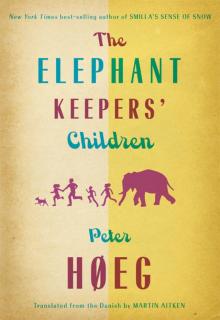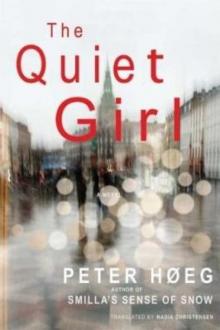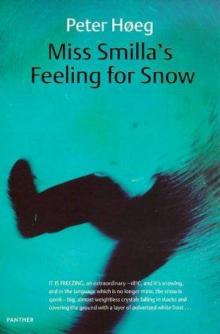- Home
- Peter Høeg
Smilla's Sense of Snow Page 9
Smilla's Sense of Snow Read online
Page 9
The room has two windows high on the wall facing Strand Boulevard, and four toward the factory grounds. This is where my preparations with the plastic bags come in. I thought I would cover the windows so I can turn on a light.
There are women who paint their own attractive attic apartments themselves. Reupholster the furniture. Sandblast the façade. I have always called on a professional. Or let it wait until next year.
These windows are large, with iron bars on the inside. It takes me forty-five minutes to drape all six.
When I’m finished I don’t dare turn on the overhead lights, after all, but make do with my flashlight.
Merciless order ought to prevail in archives. They are quite simply the crystallization of a wish to put the past in order. So that busy, energetic young people can come waltzing in, select a specific case, a specific core sample, and waltz out again with precisely that segment of the past.
These archives, on the other hand, leave something to be desired. There are no signs on the shelves. There are no numbers, dates, or letters on the spines of the filed material. And when I select a couple at random, I get: Coal petrographic analyses on seams from Atâ (low group profiles), Nûgssuaq, West Greenland, and On the use of processed raw cryolite in the production of electric light bulbs, and Demarcation of borders at the land parceling of 1862.
I go upstairs and make a phone call. It always feels wrong to call someone on the phone. It feels especially wrong to call from the scene of the crime. As if I had gotten a direct line to police headquarters to turn myself in.
“This is Elsa Lübing.”
“I’m standing here amid mountains of papers trying to remember where it says something about the fact that even the chosen ones risk being led astray.”
First she hesitates, then she laughs.
“In Matthew. But perhaps more appropriate on this occasion would be Mark, where Jesus says: ‘Are you not therefore mistaken, because you do not know the Scriptures nor the power of God?’”
We giggle together on the phone.
“I disavow any responsibility,” she says. “I’ve asked for a cleanup and cataloging for forty-five years.”
“I’m so glad there’s something you didn’t manage to get done.”
She’s silent on the phone.
“Where?” I ask.
“There are two shelves above the bench—the long wooden case. That’s where the expedition reports are. Arranged alphabetically according to the minerals they were looking for. The volumes closest to the window are the trips that had both a geological and a historical purpose. The one you’re looking for should be one of the last ones.”
She’s about to hang up.
“Miss Lübing,” I say.
“Yes?”
“Did you ever take a sick day?”
“The Lord has watched over me.”
“I thought so,” I say. “I could sort of tell.”
Then we hang up.
It takes me less than two minutes to find the report. It’s in a black ring binder. There are forty pages, numbered in the lower-right-hand corner.
It’s just the right size to stuff into my handbag. Afterward I have to remove the plastic blackout curtains, and I’ll disappear down Kalkbrænderi Road without a trace, just the way I arrived.
I can’t restrain my curiosity. I take the report over to the far corner of the room and sit down on the floor, leaning against a bookcase. It gives under my weight. It’s a flimsy, wooden bookcase. They never thought that the archives would get so big. That Greenland would be so surprisingly inexhaustible. They’ve simply filled up the shelves. The traces of time on a flimsy wooden skeleton.
“The geologic expedition of the Cryolite Corporation of Denmark to Gela Alta, July through August 1991,” it says on the title page. Then follow twenty closely typed pages of expedition report. I skim the first pages, which start off by describing the objective of the expedition: “To investigate the deposits of granular ruby crystals on the Barren Glacier on Gela Alta.” The text also lists the five European members of the expedition. Among others, a professor of Arctic ethnology, Dr. Andreas Fine Licht, Ph.D. The name rings a bell somewhere deep inside me. But when I try to listen, it stops. I assume that his presence explains why it says at the bottom that the expedition is supported by the Institute for Arctic Ethnology.
Next comes a report with both an English and a Danish section. I page through this part, too. It concerns a rescue operation from Holsteinsborg to Barren Glacier by helicopter. The helicopter wasn’t able to land very close because of the risk of avalanche from the engine noise. That’s why it turned around and they sent a Cherokee 6—3000 instead, whatever that is, but it says that it landed on the water, with a pilot, navigator, doctor, and nurse on board. There’s a brief report from the rescue team and a doctor’s certificate from the hospital. There were five fatalities. One Finn and four Inuits. One of the Inuits was named Norsaq Christiansen.
There is a twenty-page appendix. A summary of the mineralogical samples brought back. The logs. A series of black-and-white aerial photos of a glacier, splitting and floating around a bright, fractured conical cliff.
A plastic folder contains copies of about twenty letters, all concerning transport of the bodies.
The whole thing looks clean and aboveboard. It’s tragic, and yet something that might happen. Nothing that could explain why a little boy, two years later, falls off a rooftop in Copenhagen. It occurs to me that I’ve been seeing ghosts. That I’ve gone astray. That it’s all a figment of my imagination.
For the first time I notice how burdened the room is with the past. With hundreds of days, hundreds of numbers, hundreds of people, who every day, year in and year out, have eaten their two sandwiches in the cafeteria and shared a beer with Amanda, but never more than one except at Christmas, when the laboratory spikes a 6½ gallon carboy of 96-proof disinfecting alcohol with cumin for the Christmas party. The archives are shouting at me that they have been content. And that’s also what it said in the book at the library, and what Elsa Lübing said: “We were content. It was a good place to work.”
As so often before, I feel a yearning to participate, to take part. In Thule and Siorapaluk no one ever asked people what they did, because everybody was a hunter, everybody had work to do. In Denmark, if you are a wage earner, it lends meaning and fulfillment to your life to know that now you’re rolling up your sleeves and putting a pen behind your ear and pulling up your bootstraps and going to work. And when you’re off, you watch TV or visit friends or play badminton or take a night course in Basic. You don’t live life in a cellar beneath Strand Boulevard in the middle of the night at Christmastime.
This is not the first or the last time that I have had these thoughts. What is it that makes us seek out the plunge into depression?
As I close the report, I have an idea. I open it again and page through to the medical report. There I see something. And then I know that it’s been worth all the trouble.
I’ve seen girlfriends in Greenland who, discovering that they’re pregnant, suddenly take better care of themselves than ever before. That’s the feeling that passes over me now. From now on I have to watch out for myself.
The traffic has stopped. I don’t wear a watch, but it must be about 3:00 a.m. I switch off my flashlight.
The building is quiet. In the silence there is suddenly a sound that is wrong. It’s too close to be coming from the street. But faint, like a whisper. From where I’m sitting, the doorway into the first small room is a faintly lit gray rectangle. One moment it’s visible, the next it’s not. Someone has stepped into the room, someone who is blocking the light with his body.
By moving my head slightly I can follow his movement along the shelves. I take off my boots. They’re no good for running. I stand up. By moving my head slightly I can place the figure inside the faintly lit frame of the doorway.
We think there are limits to the dimensions of fear. Until we encounter the unknown. Then we can all feel
boundless amounts of terror.
I take hold of one of the bookcases and topple it toward him. Just as it picks up speed, the first volumes fall out. That warns him, and he puts up his hands and tries to stop the bookcase. First it sounds like the bones of his forearms are snapping. Then what sounds like fifteen tons of books fall onto the floor. He can’t let go of the bookcase. But it’s resting very heavily on him. And slowly his legs begin to buckle.
The misconception that violence always favors the physically strong has spread to a large segment of the population. It’s not correct. The results of a fight are a matter of speed in the first few yards. When I moved out to Skovgårds School after six months at Rugmarkens School, I encountered for the first time the classic Danish persecution of those who are different. In the school we came from, we were all foreigners and in the same boat. In my new class I was the only one with black hair and broken Danish. There was one boy in particular, from one of the older classes, who was really quite brutal. I found out where he lived. Then I got up early and waited for him where he crossed Skovshoved Road. He was thirty pounds heavier than I was. He didn’t have a chance. He never got the couple of minutes that he needed to work himself into a trance. I hit him right in the face and broke his nose. I kicked him on one kneecap and then on the other, to bring him down to a more acceptable height. It took twelve stitches to put his nasal septum back in place. No one ever really believed that it could have been me.
This time I don’t stand there picking my nose either, waiting for Christmas to arrive. From the wall I grab one of the brass rods with fifty topographical maps attached and hit him as hard as I can on the back of the neck.
He drops at once. The bookcase comes down on top of him. I wait for a moment. To see whether he has any friends with him. Or a little dog. But there is no sound except his breathing from under thirty yards of bookcase.
I shine my flashlight on his face. A great deal of dust has settled on him. The blow has split the edge of one ear.
He’s wearing black sweatpants, a dark blue sweater, a black wool cap, dark blue deck shoes, and a guilty conscience. It’s the mechanic.
“Clumsy Peter,” I say. “What’s the matter, did you trip?”
He can’t answer because of the bookcase. I try to push it aside, but it won’t budge.
I have to give up on professional precautions and turn on the light. I start in shoveling papers, books, folders, reports, and bookends made of solid steel away from the bookcase. I have to clear away nine feet. It takes fifteen minutes. Then I can lift it an inch, and he crawls out on his own. Over to the wall, where he sits down, feeling his skull.
Not until then do my legs start to shake.
“My vision is blurry,” he says. “I think I have a c-concussion.”
“We can always hope so,” I say.
It takes fifteen minutes before he can stand up. And even then he’s like Bambi on the ice. It takes another half hour to get the bookcase upright. We have to take off all the papers first before we can lift it and then put them all back. It gets so hot that I have to take off my skirt and work in my tights. He walks around barefoot and bare-chested and gets frequent hot flashes and dizzy spells and has to rest. Shock and unanswered questions hang in the air along with enough dust to fill a sandbox.
“It smells like fish in here, Smilla.”
“Cod liver,” I say. “It’s supposed to be so healthy.”
He watches in silence as I open the electronic safe and hang the key in its place. Then we lock up after us. He leads me over to a gate in the fence facing Svaneke Street. It’s open. After we go through, he bends over the lock and it clicks shut.
His car is parked on the next street. I have to support him with one hand. In the other I’m carrying a garbage bag full of other garbage bags. A patrol car passes us slowly, but without stopping. They see so much going on in the streets at this time of year. People should be allowed to amuse themselves in whatever manner they choose.
He tells me that he’s trying to get his car accepted by a classic car museum. It’s a ’61 Morris 1000, he tells me. With red leather seats and wooden top and instrument panel.
“I can’t drive,” he says.
“I don’t have a license.”
“Have you ever driven before?”
“Snow-cats on the ice cap.”
But he wasn’t going to subject his Morris to that. So he drives. There’s barely room for his large body behind the wheel. The top is full of holes and we’re freezing. I wish that he had succeeded in getting it into a museum a long time ago.
The temperature has fallen from just below freezing to hard frost, and on our way home it starts to snow. With qanik, fine-grained powder snow.
The most dangerous kind of avalanches are powder snow avalanches. They’re set off by extremely small energy disturbances, such as a loud noise. They have a very small mass, but they move at 125 miles per hour, and they leave behind them a deadly vacuum. There are people who have had their lungs sucked out of their bodies by powder snow avalanches.
In miniature form, these are the kind of avalanche that started on the steep, slippery roof that Isaiah fell from and which I now force myself to look up at. One of the things you can learn from snow is the way great forces and catastrophes can always be found in miniature form in daily life. Not one day of my adult life has passed that I haven’t been amazed at how poorly Danes and Greenlanders understand each other. It’s worse for Greenlanders, of course. It’s not healthy for the tightrope walker to be misunderstood by the person who’s holding the rope. And in this century the Inuit’s life has been a tightrope dance on a cord fastened on one end to the world’s least hospitable land with the world’s most severe and fluctuating climate, and fastened on the other end to the Danish colonial administration.
That’s the big picture. The little everyday picture is that I have lived on the floor above the mechanic for a year and a half, have spoken to him countless times, and he has fixed my doorbell and repaired my bicycle, and I have helped him check a letter to the housing authorities for spelling mistakes. There were about twenty misspelled words out of a total of twenty-eight. He’s dyslexic.
We ought to take a shower and rinse off the dust and the blood and the cod liver. But we are bound together by what has happened. So we both go up to his apartment. Where I’ve never been before.
Order reigns in the living room. The furniture is made of sanded, lye-treated blond wood, with cushions and upholstery of woolen horse blankets. There are candlesticks with candles, a bookcase with books, a bulletin board with photographs and kids’ drawings by the children of friends. “To Big Peter from Mara, five years old.” There are rosebushes in large porcelain pots, and they have red blossoms, and it looks as if someone waters them and talks to them and promises them that they will never be sent on vacation to my place, where, for some strange reason, the climate is bad for green plants.
“C–coffee?”
Coffee is poison. And yet I suddenly have the urge to roll in the mud and I say, “Yes, please.”
I stand in the doorway and watch while he makes it. The kitchen is completely white. He takes up his position in the middle, the way a badminton player does on the court, so he has to move as little as possible. He has a little electric grinder. First he grinds a lot of light-colored beans and then some that are tiny, almost black, and shiny as glass. He mixes them in a little metal funnel that he attaches to an espresso machine, which he places on a gas burner.
People acquire bad coffee habits in Greenland. I pour hot milk right onto the Nescafé. I’m not above dissolving the powder in water straight from the hot-water tap.
He pours one part whipping cream and two parts whole milk into two tall glasses with handles.
When he draws out the coffee from the machine, it’s thick and black like crude oil. Then he froths the milk with the steam nozzle and divides the coffee between the two glasses.
We take it out to the sofa. I do appreciate it when someone
serves me something good. In the tall glasses the drink is dark as an old oak tree and has an overwhelming, almost perfumed tropical scent.
“I was following you,” he says.
The glass is scorching hot. The coffee is scalding. Normally hot drinks lose heat when they’re poured. But in this case the steam nozzle has heated up the glass to 200°F along with the milk.
“The door’s open. So I go in. I had no idea that you’d be s-sitting in the d-dark waiting.”
I cautiously sip at the rim. The drink is so strong that it makes my eyes water and I can suddenly feel my heart.
“I’d been thinking about what you said on the roof. About the footprints.”
His stammer is barely noticeable now. Sometimes it vanishes entirely.
“We were friends, you know. He was so young. But we were still friends … We don’t talk much. But we have fun. Damn, we sure have fun. He m-makes faces. He puts his head in his hands. And he raises it, and he looks like a sick old monkey. He hides it again. He raises it. He looks like a rabbit. Again and he looks like Frankenstein’s monster. I’m on the floor and finally I have to tell him to stop it. I give him a block of wood and a chisel. A knife and a piece of soapstone. He sits there swaying and rumbling like a little bear. Every so often he says something. But it’s in Greenlandic. Talking to himself. So we sit and work. Independently but together. I’m surprised he can be such a good person, with a mother like that.”
He pauses for a long time, hoping I’ll take over. But I don’t come to his rescue. We both know that I’m the one who deserves an explanation.
“So one night we’re sitting there as usual. Then Petersen the custodian comes in. He keeps his wine carboys under the stairs next to the furnace. Comes in to get his apricot wine. He’s not usually there that time of day. So there he is with his deep voice and his wooden clogs. And then I happen to look down at the boy. And he’s sitting all huddled up. Like an animal. With the knife you gave him in his hand. Shaking all over. Looking ferocious. Even after he realized it was only Petersen, he still kept shaking. I take him on my lap. For the first time. I talk to him. He doesn’t want to go home. I b-bring him up here. Put him on the sofa. I think about calling you up, but what would I say? We don’t know each other very well. He sleeps here. I stay up, sitting next to the sofa. Every fifteen minutes he bolts up like a spring, shaking and crying.”

 The Woman and the Ape
The Woman and the Ape Smilla's Sense of Snow
Smilla's Sense of Snow Borderliners
Borderliners The Susan Effect
The Susan Effect The History of Danish Dreams
The History of Danish Dreams The Elephant Keepers' Children
The Elephant Keepers' Children The Quiet Girl - Peter Hoeg
The Quiet Girl - Peter Hoeg Smilla's Sense of Snow aka Miss Smilla's Feeling for Snow
Smilla's Sense of Snow aka Miss Smilla's Feeling for Snow